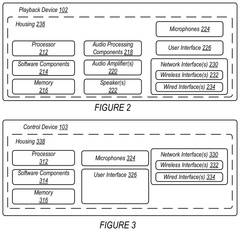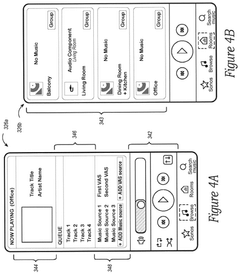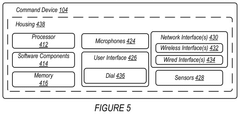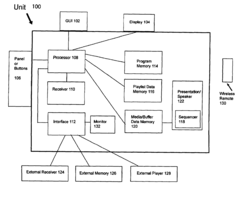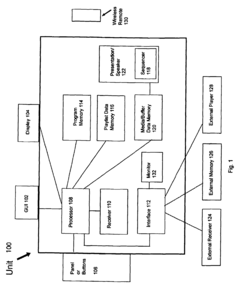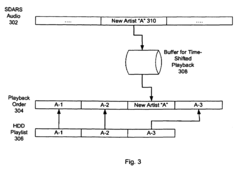How LDAC Transforms Music Streaming Experiences?
JUL 4, 20258 MIN READ
Generate Your Research Report Instantly with AI Agent
Patsnap Eureka helps you evaluate technical feasibility & market potential.
LDAC Technology Evolution
LDAC technology has undergone significant evolution since its introduction by Sony in 2015. Initially developed to address the limitations of existing Bluetooth audio codecs, LDAC has continuously improved to enhance the quality of wireless audio streaming.
In its early stages, LDAC focused on achieving high-resolution audio transmission over Bluetooth. The first iteration of LDAC supported a maximum bitrate of 990 kbps, which was a substantial improvement over the standard SBC codec used in most Bluetooth devices at the time. This allowed for near CD-quality audio streaming, setting a new benchmark in wireless audio fidelity.
As the technology matured, Sony introduced adaptive bitrate capabilities to LDAC. This feature enabled the codec to dynamically adjust its bitrate based on the connection quality, ensuring a stable audio stream even in challenging wireless environments. The adaptive bitrate ranged from 330 kbps to 990 kbps, with three distinct modes: 330 kbps, 660 kbps, and 990 kbps.
The next significant milestone in LDAC's evolution was its integration into the Android Open Source Project (AOSP) in 2017. This move greatly expanded LDAC's reach, making it available to a wide range of Android devices and encouraging adoption by other manufacturers. As a result, LDAC became one of the most widely supported high-quality Bluetooth audio codecs in the mobile industry.
Further advancements in LDAC technology focused on reducing latency and improving power efficiency. These improvements were crucial for enhancing the user experience, particularly in applications such as gaming and video streaming where audio-visual synchronization is critical. The reduced latency also benefited real-time audio applications like voice calls and live music performances.
Recent developments in LDAC have centered on expanding its compatibility with various audio formats and improving its performance in multi-device scenarios. The codec now supports a wider range of audio resolutions, including 24-bit/96kHz, which is considered the gold standard for high-resolution audio. Additionally, efforts have been made to optimize LDAC for true wireless stereo (TWS) earbuds, addressing the unique challenges of maintaining high-quality audio across two separate wireless connections.
Looking ahead, the evolution of LDAC is likely to continue in several directions. These may include further improvements in power efficiency to extend battery life, enhanced multi-device support for seamless audio sharing, and potential integration with emerging wireless technologies like Wi-Fi 6E or UWB for even higher bandwidth and lower latency audio transmission.
In its early stages, LDAC focused on achieving high-resolution audio transmission over Bluetooth. The first iteration of LDAC supported a maximum bitrate of 990 kbps, which was a substantial improvement over the standard SBC codec used in most Bluetooth devices at the time. This allowed for near CD-quality audio streaming, setting a new benchmark in wireless audio fidelity.
As the technology matured, Sony introduced adaptive bitrate capabilities to LDAC. This feature enabled the codec to dynamically adjust its bitrate based on the connection quality, ensuring a stable audio stream even in challenging wireless environments. The adaptive bitrate ranged from 330 kbps to 990 kbps, with three distinct modes: 330 kbps, 660 kbps, and 990 kbps.
The next significant milestone in LDAC's evolution was its integration into the Android Open Source Project (AOSP) in 2017. This move greatly expanded LDAC's reach, making it available to a wide range of Android devices and encouraging adoption by other manufacturers. As a result, LDAC became one of the most widely supported high-quality Bluetooth audio codecs in the mobile industry.
Further advancements in LDAC technology focused on reducing latency and improving power efficiency. These improvements were crucial for enhancing the user experience, particularly in applications such as gaming and video streaming where audio-visual synchronization is critical. The reduced latency also benefited real-time audio applications like voice calls and live music performances.
Recent developments in LDAC have centered on expanding its compatibility with various audio formats and improving its performance in multi-device scenarios. The codec now supports a wider range of audio resolutions, including 24-bit/96kHz, which is considered the gold standard for high-resolution audio. Additionally, efforts have been made to optimize LDAC for true wireless stereo (TWS) earbuds, addressing the unique challenges of maintaining high-quality audio across two separate wireless connections.
Looking ahead, the evolution of LDAC is likely to continue in several directions. These may include further improvements in power efficiency to extend battery life, enhanced multi-device support for seamless audio sharing, and potential integration with emerging wireless technologies like Wi-Fi 6E or UWB for even higher bandwidth and lower latency audio transmission.
High-Res Audio Market Trends
The high-resolution audio market has experienced significant growth in recent years, driven by increasing consumer demand for superior sound quality and immersive listening experiences. This trend is particularly evident in the music streaming sector, where platforms are increasingly offering high-resolution audio options to differentiate themselves and cater to audiophiles and discerning listeners.
The global high-resolution audio market is projected to continue its upward trajectory, with a compound annual growth rate (CAGR) expected to exceed 20% over the next five years. This growth is fueled by several factors, including advancements in audio technology, the proliferation of high-quality audio devices, and a growing appreciation for lossless audio formats among consumers.
One of the key drivers of this market trend is the increasing adoption of high-resolution audio streaming services. Major players like Tidal, Amazon Music HD, and Qobuz have been at the forefront of offering lossless and high-resolution audio streaming options, with other industry giants such as Apple Music and Spotify following suit. This shift towards higher quality audio streaming is reshaping consumer expectations and pushing the boundaries of digital music delivery.
The rise of wireless audio technologies, such as LDAC, has played a crucial role in enabling high-resolution audio streaming over Bluetooth connections. LDAC, developed by Sony, allows for the transmission of high-resolution audio at up to 990 kbps, significantly higher than standard Bluetooth codecs. This technology has been instrumental in bridging the gap between wireless convenience and audiophile-grade sound quality, further driving the adoption of high-resolution audio in the streaming market.
Another notable trend is the increasing integration of high-resolution audio support in smartphones and portable devices. As more manufacturers incorporate high-quality DACs (Digital-to-Analog Converters) and support for high-resolution audio formats in their devices, the accessibility of high-fidelity music on-the-go has improved dramatically. This trend is expected to continue, with mobile devices becoming increasingly capable of delivering studio-quality audio experiences.
The automotive industry has also emerged as a significant market for high-resolution audio, with luxury car manufacturers integrating advanced audio systems capable of reproducing high-fidelity sound. This trend is expected to trickle down to mid-range vehicles, further expanding the market for high-resolution audio technologies and content.
As the high-resolution audio market continues to evolve, we can expect to see further innovations in audio codecs, streaming technologies, and hardware capabilities. The ongoing development of technologies like LDAC will play a crucial role in shaping the future of music streaming experiences, offering consumers unprecedented levels of audio quality and fidelity.
The global high-resolution audio market is projected to continue its upward trajectory, with a compound annual growth rate (CAGR) expected to exceed 20% over the next five years. This growth is fueled by several factors, including advancements in audio technology, the proliferation of high-quality audio devices, and a growing appreciation for lossless audio formats among consumers.
One of the key drivers of this market trend is the increasing adoption of high-resolution audio streaming services. Major players like Tidal, Amazon Music HD, and Qobuz have been at the forefront of offering lossless and high-resolution audio streaming options, with other industry giants such as Apple Music and Spotify following suit. This shift towards higher quality audio streaming is reshaping consumer expectations and pushing the boundaries of digital music delivery.
The rise of wireless audio technologies, such as LDAC, has played a crucial role in enabling high-resolution audio streaming over Bluetooth connections. LDAC, developed by Sony, allows for the transmission of high-resolution audio at up to 990 kbps, significantly higher than standard Bluetooth codecs. This technology has been instrumental in bridging the gap between wireless convenience and audiophile-grade sound quality, further driving the adoption of high-resolution audio in the streaming market.
Another notable trend is the increasing integration of high-resolution audio support in smartphones and portable devices. As more manufacturers incorporate high-quality DACs (Digital-to-Analog Converters) and support for high-resolution audio formats in their devices, the accessibility of high-fidelity music on-the-go has improved dramatically. This trend is expected to continue, with mobile devices becoming increasingly capable of delivering studio-quality audio experiences.
The automotive industry has also emerged as a significant market for high-resolution audio, with luxury car manufacturers integrating advanced audio systems capable of reproducing high-fidelity sound. This trend is expected to trickle down to mid-range vehicles, further expanding the market for high-resolution audio technologies and content.
As the high-resolution audio market continues to evolve, we can expect to see further innovations in audio codecs, streaming technologies, and hardware capabilities. The ongoing development of technologies like LDAC will play a crucial role in shaping the future of music streaming experiences, offering consumers unprecedented levels of audio quality and fidelity.
LDAC Technical Challenges
LDAC, developed by Sony, represents a significant advancement in Bluetooth audio codec technology. However, it faces several technical challenges that impact its widespread adoption and optimal performance in music streaming experiences.
One of the primary challenges is the high bandwidth requirement for LDAC's highest quality mode. At 990 kbps, it demands considerably more data throughput than standard Bluetooth audio codecs. This can lead to connectivity issues, especially in environments with high electromagnetic interference or when the device is at the edge of the Bluetooth range.
Another challenge lies in the power consumption of LDAC. The codec's high-quality audio processing requires more computational power, which can result in increased battery drain on both the transmitting and receiving devices. This is particularly noticeable on mobile devices where battery life is a critical factor for user experience.
LDAC's adaptive bitrate feature, while beneficial for maintaining connection stability, introduces its own set of challenges. The codec must seamlessly switch between different quality modes (990, 660, and 330 kbps) based on connection quality. Implementing this feature without introducing audible artifacts or interruptions in the audio stream requires sophisticated algorithms and precise timing.
Compatibility is another significant hurdle for LDAC. Despite being part of the Android Open Source Project since Android 8.0, not all Android devices support LDAC. This fragmentation in the Android ecosystem limits the codec's reach. Moreover, LDAC is not natively supported on iOS devices, which excludes a large portion of the mobile market.
The complexity of LDAC's encoding and decoding processes also presents challenges for hardware manufacturers. Implementing LDAC support requires specific hardware capabilities and optimizations, which can increase the cost and complexity of audio devices.
Latency is another area where LDAC faces challenges, particularly in gaming and video applications. While LDAC offers improved latency compared to some other high-quality codecs, it still introduces a delay that can be noticeable in scenarios requiring precise audio-visual synchronization.
Lastly, the proprietary nature of LDAC, despite its inclusion in Android, poses challenges for widespread adoption. Unlike open codecs, the development and improvement of LDAC are primarily driven by Sony, which can limit innovation and integration from the broader audio technology community.
One of the primary challenges is the high bandwidth requirement for LDAC's highest quality mode. At 990 kbps, it demands considerably more data throughput than standard Bluetooth audio codecs. This can lead to connectivity issues, especially in environments with high electromagnetic interference or when the device is at the edge of the Bluetooth range.
Another challenge lies in the power consumption of LDAC. The codec's high-quality audio processing requires more computational power, which can result in increased battery drain on both the transmitting and receiving devices. This is particularly noticeable on mobile devices where battery life is a critical factor for user experience.
LDAC's adaptive bitrate feature, while beneficial for maintaining connection stability, introduces its own set of challenges. The codec must seamlessly switch between different quality modes (990, 660, and 330 kbps) based on connection quality. Implementing this feature without introducing audible artifacts or interruptions in the audio stream requires sophisticated algorithms and precise timing.
Compatibility is another significant hurdle for LDAC. Despite being part of the Android Open Source Project since Android 8.0, not all Android devices support LDAC. This fragmentation in the Android ecosystem limits the codec's reach. Moreover, LDAC is not natively supported on iOS devices, which excludes a large portion of the mobile market.
The complexity of LDAC's encoding and decoding processes also presents challenges for hardware manufacturers. Implementing LDAC support requires specific hardware capabilities and optimizations, which can increase the cost and complexity of audio devices.
Latency is another area where LDAC faces challenges, particularly in gaming and video applications. While LDAC offers improved latency compared to some other high-quality codecs, it still introduces a delay that can be noticeable in scenarios requiring precise audio-visual synchronization.
Lastly, the proprietary nature of LDAC, despite its inclusion in Android, poses challenges for widespread adoption. Unlike open codecs, the development and improvement of LDAC are primarily driven by Sony, which can limit innovation and integration from the broader audio technology community.
LDAC Implementation Strategies
01 LDAC codec implementation for high-quality audio streaming
LDAC is a high-resolution audio codec developed for Bluetooth audio streaming. It enables the transmission of high-quality audio data over Bluetooth connections, providing a superior listening experience compared to standard codecs. LDAC supports various bit rates and can adapt to different network conditions, ensuring optimal audio quality and stability during music streaming.- LDAC codec implementation for high-quality audio streaming: LDAC is a high-resolution audio codec developed for Bluetooth audio streaming. It enables the transmission of high-quality audio data over Bluetooth connections, providing a superior listening experience compared to standard codecs. LDAC supports various bit rates and can adapt to different network conditions, ensuring optimal audio quality and stability during music streaming.
- Music streaming device and system optimization: Innovations in music streaming devices and systems focus on optimizing the streaming experience. This includes improvements in data transmission, buffering techniques, and adaptive bitrate streaming. These advancements aim to reduce latency, minimize interruptions, and enhance overall audio quality, particularly when using high-fidelity codecs like LDAC.
- User interface and experience enhancements for music streaming: Developments in user interfaces and experience design for music streaming applications aim to improve usability and engagement. This includes features such as personalized recommendations, seamless playlist management, and intuitive controls for adjusting audio settings, including LDAC-specific options when available.
- Integration of LDAC with smart home and IoT devices: The integration of LDAC technology with smart home and Internet of Things (IoT) devices expands the possibilities for high-quality audio streaming throughout connected environments. This allows for seamless audio distribution across multiple devices and rooms, enhancing the overall music listening experience in smart homes.
- Mobile device optimization for LDAC streaming: Specific optimizations for mobile devices to support LDAC streaming focus on power efficiency, heat management, and performance enhancements. These improvements aim to provide a high-quality LDAC streaming experience on smartphones and portable devices without significantly impacting battery life or device performance.
02 Music streaming device and system optimization
Innovations in music streaming devices and systems focus on optimizing the streaming experience. This includes improvements in data transmission, buffering techniques, and device compatibility. These advancements aim to reduce latency, minimize interruptions, and enhance overall audio quality, resulting in a seamless and enjoyable music streaming experience for users.Expand Specific Solutions03 User interface and playlist management for music streaming
Developments in user interface design and playlist management systems for music streaming applications aim to enhance user experience. These innovations include intuitive navigation, personalized recommendations, and efficient playlist creation and management tools. Such features allow users to easily discover, organize, and enjoy their music, improving the overall streaming experience.Expand Specific Solutions04 Network optimization for music streaming
Advancements in network optimization techniques for music streaming focus on improving data transmission efficiency and reducing bandwidth consumption. These innovations include adaptive streaming technologies, intelligent caching mechanisms, and network traffic management. Such optimizations ensure smooth playback and high-quality audio even in challenging network conditions.Expand Specific Solutions05 Integration of music streaming with other devices and platforms
Innovations in integrating music streaming services with various devices and platforms aim to provide a seamless and connected listening experience. This includes developments in smart home integration, automotive audio systems, and cross-platform synchronization. These advancements allow users to enjoy their music across different environments and devices with minimal interruption.Expand Specific Solutions
LDAC Industry Ecosystem
The LDAC technology market is in a growth phase, with increasing adoption in high-quality audio streaming applications. The market size is expanding as more consumers demand superior audio experiences, particularly in wireless devices. Technologically, LDAC is relatively mature, with major players like Sony, Samsung, and LG Electronics incorporating it into their products. Companies such as Qualcomm, Huawei, and ZTE are also actively developing and implementing LDAC or similar high-resolution audio codecs. The competitive landscape is characterized by a mix of established electronics giants and innovative audio technology firms, with ongoing research and development efforts to enhance audio streaming quality and efficiency.
LG Electronics, Inc.
Technical Solution: LG has incorporated LDAC technology into its smartphones and audio products, particularly in its high-end models[14]. The company has developed its own Meridian Audio technology, which works in conjunction with LDAC to enhance the overall audio experience. LG's implementation includes a feature called Hi-Fi Quad DAC, which upscales lower resolution audio to take full advantage of LDAC's high bitrate capabilities[15]. LG has also integrated LDAC with its AI-powered sound processing algorithms to optimize audio output based on content type and listening environment[16].
Strengths: Strong integration of LDAC with proprietary audio technologies, focus on audiophile-grade features in mobile devices. Weaknesses: Declining market share in the smartphone sector, limited ecosystem compared to larger competitors.
QUALCOMM, Inc.
Technical Solution: Qualcomm, while not directly involved with LDAC, has developed its own high-quality audio codec called aptX Adaptive, which competes with LDAC in the high-resolution audio streaming market[8]. aptX Adaptive offers bitrates up to 420 kbps and supports 24-bit/48kHz audio. It uses AI-driven algorithms to dynamically adjust bitrates and minimize audio dropouts[9]. Qualcomm has integrated this technology into its Snapdragon Sound platform, which aims to provide a comprehensive high-quality wireless audio solution for smartphones and audio accessories[10].
Strengths: Widespread adoption in Android devices, lower latency compared to LDAC, comprehensive audio ecosystem. Weaknesses: Lower maximum bitrate than LDAC, not as widely supported in high-end audio equipment.
LDAC Core Innovations
Music Discovery Dial
PatentPendingUS20250077174A1
Innovation
- A command device with a 'dial' interface that allows users to tune into different streaming audio channels, pre-caching audio snippets locally to enable seamless playback transitions, and personalizing channels based on user playback history to introduce new and unexpected music.
Utilizing metadata to improve the access of entertainment content
PatentActiveUS7580325B2
Innovation
- A system utilizing metadata to enable users to select audio content based on preferences such as artists or genres, allowing playback from various sources like AM/FM, HD-Radio, SDARS, and local storage, while also creating personalized radio stations with integrated localized information.
Audio Compression Standards
Audio compression standards have played a crucial role in shaping the landscape of digital music streaming. These standards are designed to reduce the size of audio files while maintaining acceptable sound quality, enabling efficient transmission and storage of music. The evolution of these standards has been driven by the increasing demand for high-quality audio streaming experiences.
One of the earliest widely adopted audio compression standards was MP3 (MPEG-1 Audio Layer III), developed in the 1990s. MP3 revolutionized digital music distribution by significantly reducing file sizes while preserving reasonable audio quality. However, as consumer expectations for audio fidelity grew, more advanced codecs emerged to address the limitations of MP3.
Advanced Audio Coding (AAC) was introduced as a successor to MP3, offering improved compression efficiency and better sound quality at lower bitrates. AAC became the standard audio format for various digital music platforms and devices, including iTunes and YouTube. It remains widely used in streaming services due to its balance between compression and audio fidelity.
In recent years, the focus has shifted towards lossless and high-resolution audio compression standards. FLAC (Free Lossless Audio Codec) has gained popularity among audiophiles for its ability to compress audio without any loss in quality. While FLAC files are larger than their lossy counterparts, they offer perfect reproduction of the original audio source.
The advent of LDAC (Low Latency Audio Codec) marks a significant advancement in Bluetooth audio compression. Developed by Sony, LDAC aims to deliver near-lossless audio quality over Bluetooth connections. It offers higher bitrates and improved sound quality compared to traditional Bluetooth codecs like SBC (Sub-band Coding) or AAC.
As streaming services continue to evolve, new audio compression standards are being developed to meet the growing demand for high-quality audio experiences. These include formats like MQA (Master Quality Authenticated) and aptX HD, which aim to deliver studio-quality audio through efficient compression techniques.
The ongoing development of audio compression standards reflects the industry's commitment to enhancing the music streaming experience. As technology advances, we can expect further innovations in this field, potentially revolutionizing how we consume and enjoy digital music.
One of the earliest widely adopted audio compression standards was MP3 (MPEG-1 Audio Layer III), developed in the 1990s. MP3 revolutionized digital music distribution by significantly reducing file sizes while preserving reasonable audio quality. However, as consumer expectations for audio fidelity grew, more advanced codecs emerged to address the limitations of MP3.
Advanced Audio Coding (AAC) was introduced as a successor to MP3, offering improved compression efficiency and better sound quality at lower bitrates. AAC became the standard audio format for various digital music platforms and devices, including iTunes and YouTube. It remains widely used in streaming services due to its balance between compression and audio fidelity.
In recent years, the focus has shifted towards lossless and high-resolution audio compression standards. FLAC (Free Lossless Audio Codec) has gained popularity among audiophiles for its ability to compress audio without any loss in quality. While FLAC files are larger than their lossy counterparts, they offer perfect reproduction of the original audio source.
The advent of LDAC (Low Latency Audio Codec) marks a significant advancement in Bluetooth audio compression. Developed by Sony, LDAC aims to deliver near-lossless audio quality over Bluetooth connections. It offers higher bitrates and improved sound quality compared to traditional Bluetooth codecs like SBC (Sub-band Coding) or AAC.
As streaming services continue to evolve, new audio compression standards are being developed to meet the growing demand for high-quality audio experiences. These include formats like MQA (Master Quality Authenticated) and aptX HD, which aim to deliver studio-quality audio through efficient compression techniques.
The ongoing development of audio compression standards reflects the industry's commitment to enhancing the music streaming experience. As technology advances, we can expect further innovations in this field, potentially revolutionizing how we consume and enjoy digital music.
LDAC User Experience Impact
LDAC's impact on the user experience of music streaming has been transformative, elevating the quality of wireless audio to unprecedented levels. This high-resolution audio codec, developed by Sony, has significantly enhanced the listening experience for audiophiles and casual listeners alike.
The most notable improvement LDAC brings is in sound quality. By allowing for higher bitrates of up to 990 kbps, LDAC enables the transmission of near-lossless audio over Bluetooth connections. This results in a richer, more detailed soundstage that closely resembles the original studio recording. Users report hearing subtle nuances in their music that were previously imperceptible with standard Bluetooth codecs.
LDAC's adaptive bitrate feature also contributes to a more stable and consistent listening experience. The codec can dynamically adjust its bitrate based on the connection quality, ensuring that audio playback remains smooth even in challenging wireless environments. This adaptability minimizes dropouts and maintains audio fidelity, enhancing overall user satisfaction.
The codec's efficiency in data transmission has led to improvements in battery life for both streaming devices and wireless headphones. Despite the higher data throughput, LDAC's optimized encoding process helps conserve energy, allowing users to enjoy high-quality audio for extended periods without frequent recharging.
LDAC has also influenced user behavior in music consumption. With access to higher quality audio, many users report spending more time actively listening to music, rather than using it as background noise. This increased engagement has led to a greater appreciation for audio quality and has driven demand for high-resolution music streaming services.
The availability of LDAC has raised consumer expectations for wireless audio quality. Users now seek out LDAC-compatible devices when purchasing new audio equipment, indicating a shift in market preferences towards high-fidelity wireless solutions. This trend has encouraged manufacturers to prioritize audio quality in their product development, benefiting the entire ecosystem of music streaming and playback devices.
In conclusion, LDAC has significantly enhanced the user experience in music streaming by delivering superior sound quality, improving connection stability, extending battery life, and fostering a deeper engagement with music. Its impact extends beyond individual listening sessions, influencing consumer behavior and driving innovation in the audio industry.
The most notable improvement LDAC brings is in sound quality. By allowing for higher bitrates of up to 990 kbps, LDAC enables the transmission of near-lossless audio over Bluetooth connections. This results in a richer, more detailed soundstage that closely resembles the original studio recording. Users report hearing subtle nuances in their music that were previously imperceptible with standard Bluetooth codecs.
LDAC's adaptive bitrate feature also contributes to a more stable and consistent listening experience. The codec can dynamically adjust its bitrate based on the connection quality, ensuring that audio playback remains smooth even in challenging wireless environments. This adaptability minimizes dropouts and maintains audio fidelity, enhancing overall user satisfaction.
The codec's efficiency in data transmission has led to improvements in battery life for both streaming devices and wireless headphones. Despite the higher data throughput, LDAC's optimized encoding process helps conserve energy, allowing users to enjoy high-quality audio for extended periods without frequent recharging.
LDAC has also influenced user behavior in music consumption. With access to higher quality audio, many users report spending more time actively listening to music, rather than using it as background noise. This increased engagement has led to a greater appreciation for audio quality and has driven demand for high-resolution music streaming services.
The availability of LDAC has raised consumer expectations for wireless audio quality. Users now seek out LDAC-compatible devices when purchasing new audio equipment, indicating a shift in market preferences towards high-fidelity wireless solutions. This trend has encouraged manufacturers to prioritize audio quality in their product development, benefiting the entire ecosystem of music streaming and playback devices.
In conclusion, LDAC has significantly enhanced the user experience in music streaming by delivering superior sound quality, improving connection stability, extending battery life, and fostering a deeper engagement with music. Its impact extends beyond individual listening sessions, influencing consumer behavior and driving innovation in the audio industry.
Unlock deeper insights with Patsnap Eureka Quick Research — get a full tech report to explore trends and direct your research. Try now!
Generate Your Research Report Instantly with AI Agent
Supercharge your innovation with Patsnap Eureka AI Agent Platform!

